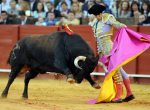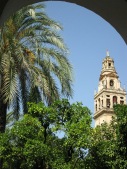Chris and I spent much of our final evening in Cordoba perched on bar stools in the Café Gaudi. This traditional tapas bar owes much to the artistic style of the renowned Catalonian architect after whom it had been named.
 We were the only tourists, surrounded by locals following their typical Sunday evening routine. As we sipped on our Cruzcampo beers, accumulating an impressive pile of empty tapas dishes, it was interesting to observe that in this particular corner of southern Spain smoking is still allowed and la corrida de toros (bullfighting) remains ever popular!
We were the only tourists, surrounded by locals following their typical Sunday evening routine. As we sipped on our Cruzcampo beers, accumulating an impressive pile of empty tapas dishes, it was interesting to observe that in this particular corner of southern Spain smoking is still allowed and la corrida de toros (bullfighting) remains ever popular!
Duels in the sun were being fought out on a large TV screen in the corner of the bar, casually followed by customers, in much the same way as Match of the Day might be in England.
Just before leaving the UK I had read that the regional parliament of Catalonia had become the first on the Spanish mainland to ban this controversial traditional art.
 For many of course it is purely and simply a blood sport and animal rights activists have secured a long-awaited victory. They are now, apparently, setting their sights on the regional parliament of Madrid.
For many of course it is purely and simply a blood sport and animal rights activists have secured a long-awaited victory. They are now, apparently, setting their sights on the regional parliament of Madrid.
They will be armed with the evidence of recent polls which suggest nearly 70% of Spaniards have little or no interest in bullfighting as a spectacle while 35% are in support of a ban.
Catalonia has a long tradition of staging contests between el matador and el toro, particularly in Barcelona, but it is a region which considers itself quite  separate from the rest of the country. Cynics are therefore suggesting that by providing such a high-profile public stance, against what is considered a Spanish national symbol, this decision smacks of political opportunism!
separate from the rest of the country. Cynics are therefore suggesting that by providing such a high-profile public stance, against what is considered a Spanish national symbol, this decision smacks of political opportunism!
Through his 1926 novel, The Sun Also Rises, Ernest Hemingway famously did much to popularise the cruel beauty of bullfighting outside of Spain. During the grey years of Franco’s dictatorship it provided a certain touch of Hollywood glamour which endured into the 1960s and the early years of the international tourist boom.
 There is no doubting the spectacle; the artistry, skill and bravery of the matador dressed in his traje de luces (suit of lights) playing the raging bull with his muleta (cape). There is also no denying the resultant gore, be it of man or beast.
There is no doubting the spectacle; the artistry, skill and bravery of the matador dressed in his traje de luces (suit of lights) playing the raging bull with his muleta (cape). There is also no denying the resultant gore, be it of man or beast.
More often than not it is the estoque (sword) of the matador that deals the estocado (death-blow) but there are huge risks and very fine, potentially fatal, margins of error when a half tonne bull lowers hits horns and charges by within inches of the torero (matador).
Top toreros in Spain are feted alongside their national football and pop idols. Jose Tomas has demanded fees of up to 400,000 Euros for providing an afternoon of thrilling spectacle for bullfighting aficionados.
 He is, however, currently recovering from a savage goring received in Mexico earlier this year. You may recall the TV images of the bull tossing him aside like a rag doll and his bloodied body being carried from the ring!
He is, however, currently recovering from a savage goring received in Mexico earlier this year. You may recall the TV images of the bull tossing him aside like a rag doll and his bloodied body being carried from the ring!
Apparently the history of bullfighting stretches back nearly 1300 years. It is undoubtedly a cultural tradition that forms part of the Spanish national identity. If its public appeal is on the wane, as polls suggest, it will die a slow death of its own.
In the meant time I suggest that the regional governments allow la corrida de toros to run its natural course and ignore the calls for a ban in much the same way as they appear to have dealt with European smoking laws!






